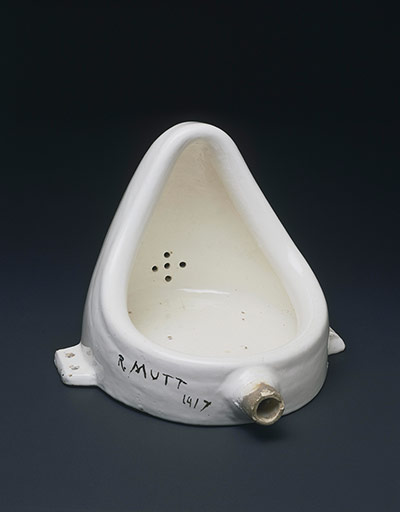
Fountain, Marcel Duchamp, 1917 (photographed by Alfred Stieglitz)
Fountain, a porcelain urinal which Duchamp signed R. Mutt, was submitted for the exhibition of the Society of Independent Artists in 1917. It was rejected by the committee. Duchamp described his intent with the piece was to shift the focus of art from physical craft to intellectual interpretation. Tomkins notes that 'it does not take much stretching of the imagination to see in the upside-down urinal's gently flowing curves the veiled head of a classic Renaissance madonna or a seated Buddha...'
In 2004 Fountain was voted the most influential artwork of the 20th century by 500 British art world professionals. This single work invented conceptual art and it has been seen as severing forever the traditional link between the artist's labour and the merit of the work.
Furthermore, Jerry Saltz noted:
'Duchamp adamantly asserted that he wanted to 'de-deify' the artist. The readymades provide a way around inflexible either-or aesthetic propositions. They represent a Copernican shift in art. Fountain is what's called an 'acheropoeitoi', an image not shaped by the hands of an artist. Fountain brings us into contact with an original that is still an original but that also exists in an altered philosophical and metaphysical state. It is a manifestation of the Kantian sublime: a work of art that transcends a form but that is also intelligible, an object that strikes down an idea while allowing it to spring up stronger'.
Fountain forced questions of what is and isn't art and what we consider to be art was never the same again.
Fountain (After Marcel Duchamp), 1991, Installation, (cast bronze)
In 1991 Sherrie Levine cast a urinal in bronze and called it Fountain (After Marcel Duchamp). By appropriating and reproducing Duchamp's work in a novel way, Levine added a new perspective and new layers of meaning. As in all of her work, the emphasis was on the vissitudes of authorship rather than aesthetics. The question that is posed concerns copies and originals. Her logic could be seen as opposite to Duchamp's: whereas he pointed at this and that, and in so doing, imported objects into the framework of art, thereby disrupting art's very parameters, Levine's object is released back into the world to circulate anew as both what it might signify and what it has accrued via this movement in and through time.
Known for addressing questions of authorship and authenticity in her work, by taking famous works of art, often making new versions of them and placing them in different contexts, Levine's take on Fountain takes the form of a replica cast in bronze and highly polished so that in some ways it formally resembles a gold buddha statue. Her copy is exact in size and shape, but what was originally a bought object is copied using a traditional approach to making sculpture, so that the object is no longer a common, store-bought object but something unique and in the process opening up more questions about the nature of art. Jerry Saltz, again: 'Her shiny urinal turns an idol of high modernism into an obviously false, self-reflecting, degraded golden calf'.
Throughout her career, Levine has created art based on works by prominent male artists from the early 20th century in order to underscore the relative absence of women in the art world, as well as the lack of representation of women artists in art history.

Fountain (Buddha), 1996 (cast bronze).
The following links are also relevant and related to this post:
http://a-place-called-space.blogspot.co.uk/2013/06/the-bride-and-bachelors.html
http://a-place-called-space.blogspot.co.uk/2013/06/sherrie-levine-after-walker-evans.html
Sources:
Johanna Burton: Sherrie Levine, Beside Herself
Craig Owens: The Discourse of Others, Feminists and Postmodernism.
The following links are also relevant and related to this post:
http://a-place-called-space.blogspot.co.uk/2013/06/the-bride-and-bachelors.html
http://a-place-called-space.blogspot.co.uk/2013/06/sherrie-levine-after-walker-evans.html
Sources:
Johanna Burton: Sherrie Levine, Beside Herself
Craig Owens: The Discourse of Others, Feminists and Postmodernism.

In a recent review of Grayson’s Perry’s ‘Playing to the Gallery’ Nicholas Lezard quotes Grayson Perry's observation that "had it not been put in a gallery" Duchamp's urinal "would not have been art, " and "if you see it" (the "original," presumably) "in a gallery today it's actually a replica, hand crafted by a potter." Unfortunately for Mr Perry, the facts are as follows. Firstly, "Duchamp's" urinal was never exhibited, in a gallery, or anywhere else, meaning that, according to Mr Perry's 'reasoning,' it wasn't art. Secondly, two of the fourteen replicas, some of which are on display in galleries around the world, were manufactured items sourced, (in the first case) from a flea market in Paris, in 1950, and the second from a public toilet in Stockholm, in 1963. Since these were manufactured industrially they were not hand made, as a potter such as Mr Perry might be expected to know. The remaining twelve were all made in 1964 by a Roman manufacturer. But none were replicas in the normal sense of the word, since they all deviate in significant detail from the original, as do Sherrie Levine’s: the original appears in the iconic photograph taken by Alfred Stieglitz on 13 April 1917. As was the practice at the time, this item was assembled by craft methods, by craftsmen, working for the Trenton Potteries Company, Trenton, New Jersey, in 1917. This confirms other evidence that proves that Duchamp could not have been responsible for its submission to the Independents in 1917. That other evidence includes a surviving example of the urinal that Stieglitz photographed still attached to a wall in a building the United States. The only accurate account of the history of 'Duchamp's' urinal is related is my own slim volume, titled Duchamp's Urinal? The Facts behind the Facade (Wild Pansy Press, 2015.)
ReplyDeleteGlyn, thank you for your thought-provoking comment. Very interesting indeed. I will now try and get hold of your book on the subject as I would like to investigate this further. Thank you.
ReplyDeleteHave fun.
ReplyDelete